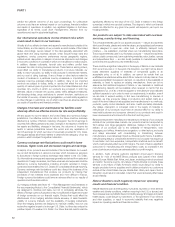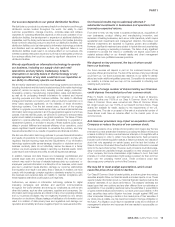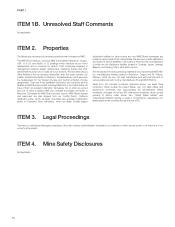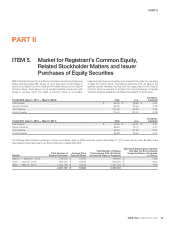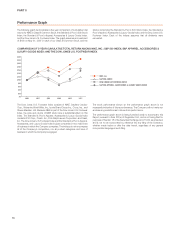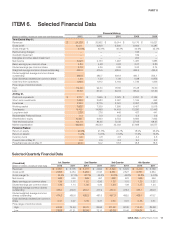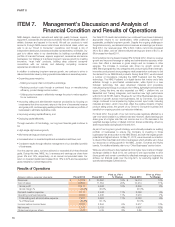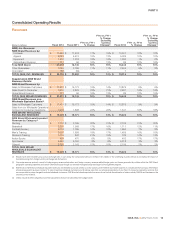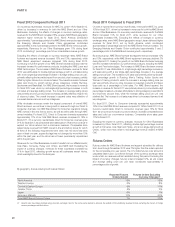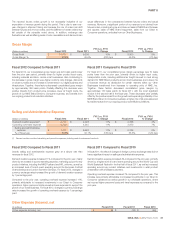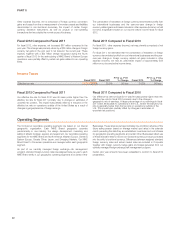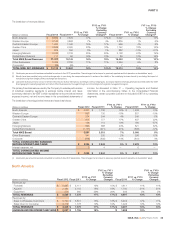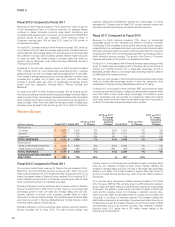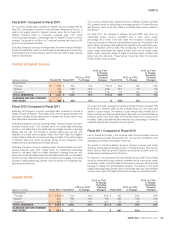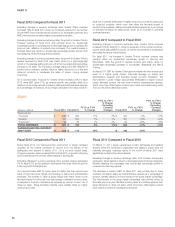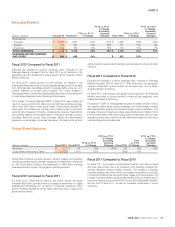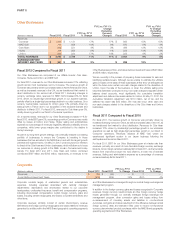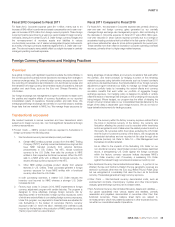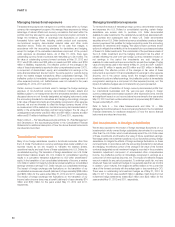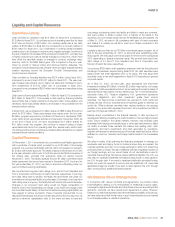Nike 2012 Annual Report Download - page 21
Download and view the complete annual report
Please find page 21 of the 2012 Nike annual report below. You can navigate through the pages in the report by either clicking on the pages listed below, or by using the keyword search tool below to find specific information within the annual report.
PART II
The reported futures orders growth is not necessarily indicative of our
expectation of revenue growth during this period. This is due to year-over-
year changes in shipment timing and because the mix of orders can shift
between futures and at-once orders, and the fulfillment of certain orders may
fall outside of the schedule noted above. In addition, exchange rate
fluctuations as well as differing levels of order cancellations and discounts can
cause differences in the comparisons between futures orders and actual
revenues. Moreover, a significant portion of our revenue is not derived from
futures orders, including at-once and close-out sales of NIKE Brand footwear
and apparel, sales of NIKE Brand equipment, sales from our Direct to
Consumer operations, and sales from our Other Businesses.
Gross Margin
(Dollars in millions) Fiscal 2012 Fiscal 2011
FY12 vs. FY11
% Change Fiscal 2010
FY11 vs. FY10
% Change
Gross Profit $ 10,471 $ 9,508 10% $ 8,800 8%
Gross Margin % 43.4% 45.6% (220) bps 46.3% (70) bps
Fiscal 2012 Compared to Fiscal 2011
For fiscal 2012, our consolidated gross margin was 220 basis points lower
than the prior year period, primarily driven by higher product input costs,
including materials and labor, across most businesses. Also contributing to
the decrease in gross margin were higher customs duty charges, discounts
on close-out sales and an increase in investments in our digital business and
infrastructure. Together, these factors decreased consolidated gross margin
by approximately 390 basis points. Partially offsetting this decrease were
positive impacts from product price increases, lower air freight costs, the
growth of our NIKE Brand Direct to Consumer business, and benefits from
our ongoing product cost reduction initiatives.
Fiscal 2011 Compared to Fiscal 2010
For fiscal 2011, our consolidated gross margin percentage was 70 basis
points lower than the prior year, primarily driven by higher input costs,
transportation costs, including additional air freight incurred to meet strong
demand for NIKE Brand products across most businesses, and a lower mix
of licensee revenue as distribution for certain markets within our Other
Businesses transitioned from licensees to operating units of NIKE, Inc.
Together, these factors decreased consolidated gross margins by
approximately 130 basis points for fiscal 2011, with the most significant
erosion in the second half of the fiscal year. These decreases were partially
offset by the positive impact from the growth and expanding profitability of our
NIKE Brand Direct to Consumer business, a higher mix of full-price sales and
favorable impacts from our ongoing product cost efficiency initiatives.
Selling and Administrative Expense
(Dollars in millions) Fiscal 2012 Fiscal 2011
FY12 vs. FY11
% Change Fiscal 2010
FY11 vs. FY10
% Change
Demand creation expense(1) $ 2,711 $ 2,448 11% $ 2,356 4%
Operating overhead expense 4,720 4,245 11% 3,970 7%
Selling and administrative
expense $ 7,431 $ 6,693 11% $ 6,326 6%
% of Revenues 30.8% 32.1% (130) bps 33.3% (120) bps
(1) Demand creation consists of advertising and promotion expenses, including costs of endorsement contracts.
Fiscal 2012 Compared to Fiscal 2011
Overall, selling and administrative expense grew at a slower rate than
revenues for fiscal 2012.
Demand creation expense increased 11% compared to the prior year, mainly
driven by an increase in sports marketing expense, marketing support for key
product initiatives, including the NIKE Fuelband and NFL uniforms, as well as
an increased level of brand event spending around the European Football
Championships and London Summer Olympics. For fiscal 2012, changes in
currency exchange rates increased the growth of demand creation expense
by 1 percentage point.
Compared to the prior year, operating overhead expense increased 11%,
primarily attributable to increased investments in our Direct to Consumer
operations, higher personnel costs as well as travel expenses to support the
growth of our overall business. For fiscal 2012, changes in currency exchange
rates increased the growth of operating overhead expense by 1 percentage
point.
Fiscal 2011 Compared to Fiscal 2010
In fiscal 2011, the effect of changes in foreign currency exchange rates did not
have a significant impact on selling and administrative expense.
Demand creation expense increased 4% compared to the prior year, primarily
driven by a higher level of brand event spending around the World Cup and
World Basketball Festival in the first half of fiscal 2011, as well as increased
spending around key product initiatives and investments in retail product
presentation with wholesale customers.
Operating overhead expense increased 7% compared to the prior year. This
increase was primarily attributable to increased investments in our Direct to
Consumer operations as well as growth in our wholesale operations, where
we incurred higher personnel costs and travel expenses as compared to the
prior year.
Other Expense (Income), net
(In millions) Fiscal 2012 Fiscal 2011 Fiscal 2010
Other expense (income), net $ 54 $ (33) $ (49)
NIKE, INC. Š2012 Form 10-K 21



